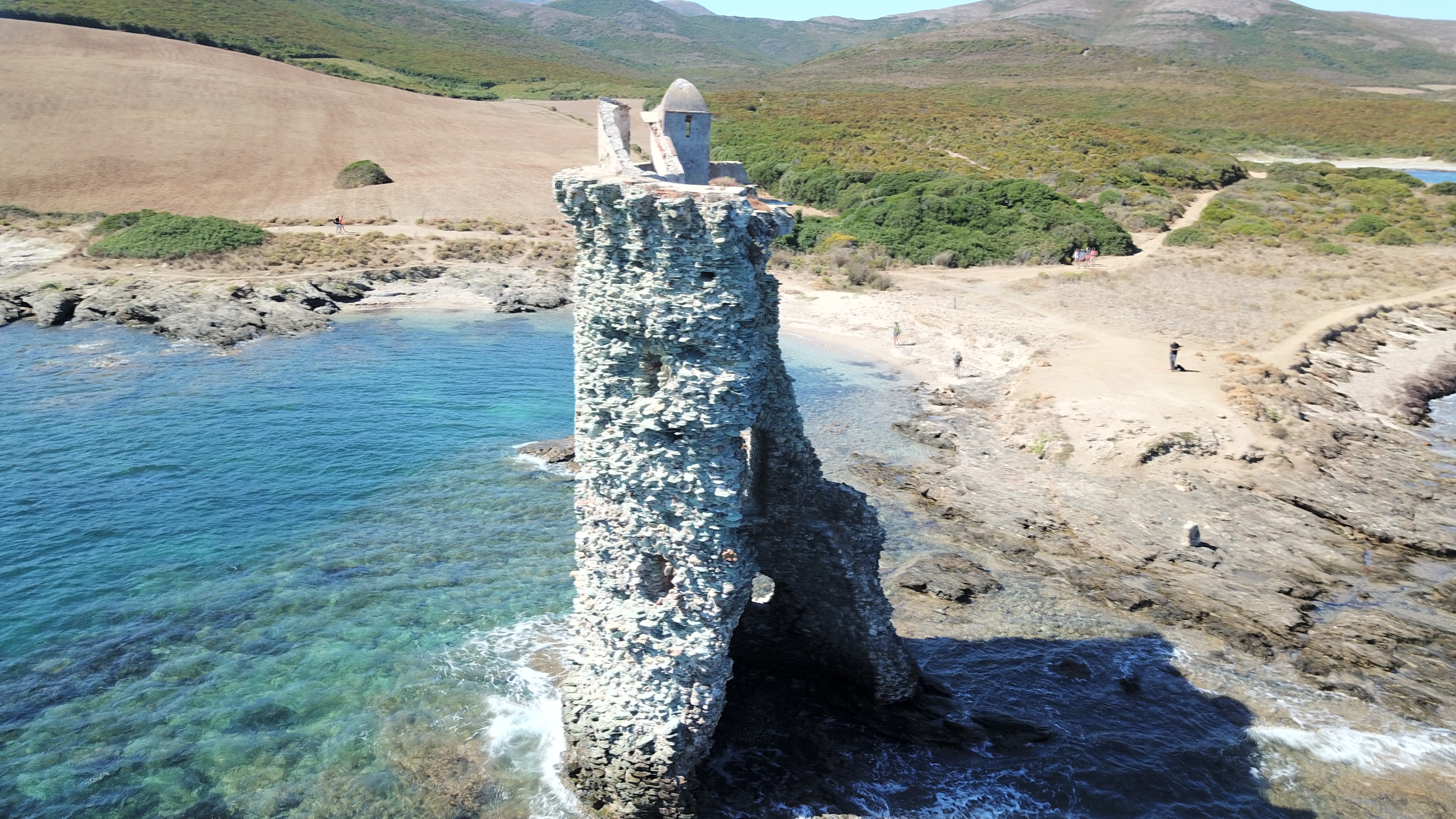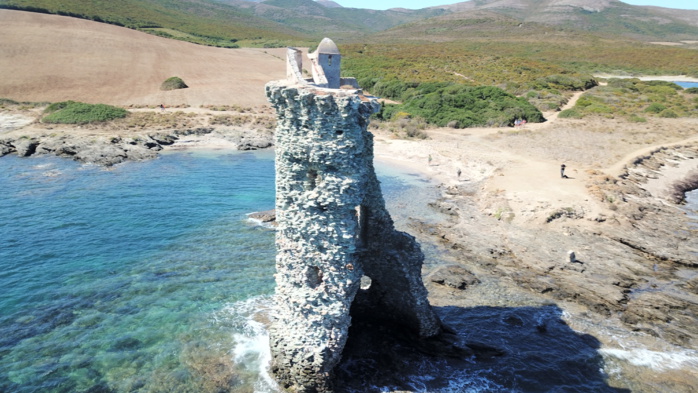| Translation : en français | in italiano |
Restoration work of the Tower, with reconstruction of the full thickness of the facing
Located 40km north of Bastia, at the entrance of the Sainte Marie harbor in the commune of Rogliano, this defensive tower of the “Piève de Santa Maria della Chiappella” was built at the instigation of the Republic of Genoa. Classified as a historical monument on 8 March 1991, it is the most important tower of the Cap Corse. Built in 1549 on a rocky outcrop, this circular tower was partially destroyed on 20 October 1793 by Admiral Nelson’s fleet during the Anglo-Corsican war (1793-1796). It is one of the most famous and photographed Genoese towers in Corsica and one of its most important landmarks. However, its current condition is very poor and it is in danger of collapsing.
The current building consists of one half of a tower in a state of disrepair in the public maritime area. Stabilised in 1998, it now requires urgent work, in particular to restore the full thickness of the tower’s parent structure which has become a very fragile structure with thin masonry. Furthermore, fracture-limiting protection must be considered to counteract the significant erosion of the masonry that threatens the stability of the tower. The stakes are all the higher as the tower is located on the Cap Corse customs route, which is visited by an ever-increasing number of tourists, around 50,000 a year, whose main aim is to discover the tower's heritage.
The project to save this Genoese tower is supported by the Heritage Mission, headed by Stéphane BERN and managed by the Fondation du Patrimoine, with the support of FDJ and the French Ministry of Culture.
The current building consists of one half of a tower in a state of disrepair in the public maritime area. Stabilised in 1998, it now requires urgent work, in particular to restore the full thickness of the tower’s parent structure which has become a very fragile structure with thin masonry. Furthermore, fracture-limiting protection must be considered to counteract the significant erosion of the masonry that threatens the stability of the tower. The stakes are all the higher as the tower is located on the Cap Corse customs route, which is visited by an ever-increasing number of tourists, around 50,000 a year, whose main aim is to discover the tower's heritage.
The project to save this Genoese tower is supported by the Heritage Mission, headed by Stéphane BERN and managed by the Fondation du Patrimoine, with the support of FDJ and the French Ministry of Culture.
A bit of history
A series of “Genoese” towers
The Corsican coastline is dotted with so-called "Genoese" towers, although not all of them were built at the instigation of the Republic of Genoa.
Most are ancient defensive fortresses, built in the early 16th century to protect villagers from invasion. After the fall of Constantinople to the Turks in 1453, barbarian raids criss-crossed the Mediterranean for almost three centuries.
In 1530, Corsica had 23 towers, including 10 on the Cap Corse, and the Republic of Genoa sent two commissioners to inspect the towers and fortifications already in place. In 1531, it was decided to build 90 coastal towers to reinforce the island's defences, including 32 on Cap Corse: a system of vigilance already in use around the Mediterranean, which consisted of placing buildings in outposts to monitor the horizon and both prevent and defend against Barbary attacks and all dangers coming from the sea.
In Corsica, the work will be supervised by two Genoese commissioners: Sebastiano Doria and Pietro Filippo Grimaldi Podio.
One of the last vestiges of Genoese military architecture in Corsica.
In 1730, there were almost 120 towers, 30 of which were on the Cap Corse. At the beginning of the 18th century, the number had fallen to 85 and today only 67 towers remain. Apart from nine citadels, the towers are the only remains of military architecture from the Genoese occupation of Corsica. Beyond this priceless historical testimony, they offer an exceptional panoramic view that has delighted hikers for generations.
The Corsican coastline is dotted with so-called "Genoese" towers, although not all of them were built at the instigation of the Republic of Genoa.
Most are ancient defensive fortresses, built in the early 16th century to protect villagers from invasion. After the fall of Constantinople to the Turks in 1453, barbarian raids criss-crossed the Mediterranean for almost three centuries.
In 1530, Corsica had 23 towers, including 10 on the Cap Corse, and the Republic of Genoa sent two commissioners to inspect the towers and fortifications already in place. In 1531, it was decided to build 90 coastal towers to reinforce the island's defences, including 32 on Cap Corse: a system of vigilance already in use around the Mediterranean, which consisted of placing buildings in outposts to monitor the horizon and both prevent and defend against Barbary attacks and all dangers coming from the sea.
In Corsica, the work will be supervised by two Genoese commissioners: Sebastiano Doria and Pietro Filippo Grimaldi Podio.
One of the last vestiges of Genoese military architecture in Corsica.
In 1730, there were almost 120 towers, 30 of which were on the Cap Corse. At the beginning of the 18th century, the number had fallen to 85 and today only 67 towers remain. Apart from nine citadels, the towers are the only remains of military architecture from the Genoese occupation of Corsica. Beyond this priceless historical testimony, they offer an exceptional panoramic view that has delighted hikers for generations.
Diagnosis
Identification of pathologies
The Collectivité de Corse owns twelve coastal towers in Corsica. Since 2015, it has been carrying out a major programme to protect and restore all this heritage. The restoration of the MIOMO and ALBU towers has been completed in 2021.
Restoration work on the FAUTEA tower began in January 2024, while work on the NONZA and A CHJAPPELLA towers will start in 2025. The FAUTEA tower has been completely surveyed, which has allowed the creation of a highly accurate 3D model of the entire building, showing all the architectural features and all the damage affecting the tower.
The following have been precisely identified:
- The different stages of construction and reconstruction of the building,
- The structural disorders, especially the fragility of the vaults and walls,
- The loss of a significant thickness of rubble stone facing on all the walls, particularly on the outside, weakening the building as a whole,
- The levelling of the machicolations, which have lost their architectural coherence in keeping with their defensive function.
- Weaknesses in the openings and bays as well as in the base of the tower on the rock,
- Remains of old rendered facings and original architectural features that are still present.
The goal of the restoration project is to restore the structural integrity and architectural coherence of this tower, which will be preserved in its ruinous state without radically altering its overall appearance.
The Collectivité de Corse owns twelve coastal towers in Corsica. Since 2015, it has been carrying out a major programme to protect and restore all this heritage. The restoration of the MIOMO and ALBU towers has been completed in 2021.
Restoration work on the FAUTEA tower began in January 2024, while work on the NONZA and A CHJAPPELLA towers will start in 2025. The FAUTEA tower has been completely surveyed, which has allowed the creation of a highly accurate 3D model of the entire building, showing all the architectural features and all the damage affecting the tower.
The following have been precisely identified:
- The different stages of construction and reconstruction of the building,
- The structural disorders, especially the fragility of the vaults and walls,
- The loss of a significant thickness of rubble stone facing on all the walls, particularly on the outside, weakening the building as a whole,
- The levelling of the machicolations, which have lost their architectural coherence in keeping with their defensive function.
- Weaknesses in the openings and bays as well as in the base of the tower on the rock,
- Remains of old rendered facings and original architectural features that are still present.
The goal of the restoration project is to restore the structural integrity and architectural coherence of this tower, which will be preserved in its ruinous state without radically altering its overall appearance.
In the future
The towers of CAPU du MURU, CAPU NERU, CAPITELLU, ERBALUNGA and NEGRU will also be included in the future. The restoration of the last two towers of PORTO and CASTELLUCCIO will complete this programme.

















